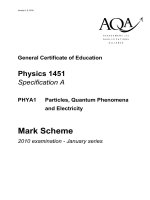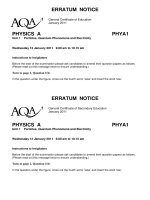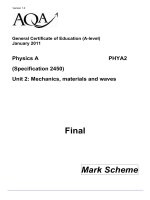- Trang chủ >>
- Khoa Học Tự Nhiên >>
- Vật lý
Vật lý A level: AQA PHYA4 1 w QP JAN10
Bạn đang xem bản rút gọn của tài liệu. Xem và tải ngay bản đầy đủ của tài liệu tại đây (73.68 KB, 12 trang )
WMP/Jan10/PHYA4/1
PHYA4/1
Centre Number
Surname
Other Names
Candidate Signature
Candidate Number
General Certificate of Education
Advanced Level Examination
January 2010
Time allowed
●
The total time for both sections of this paper is 1 hour 45 minutes. You are advised to spend
approximately 45 minutes on this section.
Instructions
●
Use black ink or black ball-point pen. Do not use pencil.
●
Answer all questions in this section.
●
For each question there are four responses. When you have selected the response which you think
is the most appropriate answer to a question, mark this response on your answer sheet.
●
Mark all responses as instructed on your answer sheet. If you wish to change your answer to a
question, follow the instructions on your answer sheet.
●
Do all rough work in this book not on the answer sheet.
Information
●
The maximum mark for this section is 25.
●
Section A and Section B of this paper together carry 20% of the total marks for Physics Advanced.
●
All questions in Section A carry equal marks. No deductions will be made for incorrect answers.
●
A Data and Formulae Booklet is provided as a loose insert.
●
The question paper/answer book for Section B is enclosed within this question paper.
In addition to this paper you will require:
● an objective test answer sheet
● a black ink or black ball-point pen
● a calculator
● a question paper/answer book for Section B (enclosed).
Physics A PHYA4/1
Unit 4 Fields and Further Mechanics
Section A
Thursday 28 January 2010 1.30 pm to 3.15 pm
WMP/Jan10/PHYA4/1
2
1 The graph shows the variation with time, t, of the force, F, acting on a body.
What physical quantity does the area X represent?
A the displacement of the body
B the acceleration of the body
C the change in momentum of the body
D the change in kinetic energy of the body
2 Water of density 1000 kg m
–3
flows out of a garden hose of cross-sectional area 7.2 × 10
–4
m
2
at a rate of 2.0 × 10
–4
m
3
per second. How much momentum is carried by the water leaving
the hose per second?
A 5.6 × 10
–5
Ns
B 5.6 × 10
–2
Ns
C 0.20 N s
D 0.72 N s
3 Which row, A to D, in the table correctly shows the quantities conserved in an inelastic
collision?
Multiple choice questions
Each of Questions 1 to 25 is followed by four responses, A, B, C and D. For each question select
the best response and mark its letter on the answer sheet.
You are advised to spend approximately 45 minutes on this section.
mass momentum kinetic energy total energy
A conserved not conserved conserved conserved
B not conserved conserved conserved not conserved
C conserved conserved conserved conserved
D conserved conserved not conserved conserved
F
0
0
t
X
3
Turn over
ᮣ
WMP/Jan10/PHYA4/1
4 What is the angular speed of a point on the Earth’s equator?
A 7.3 × 10
–5
rad s
–1
B 4.2 × 10
–3
rad s
–1
C 2.6 × 10
–1
rad s
–1
D 15 rad s
–1
5 Which one of the following does not involve a centripetal force?
A an electron in orbit around a nucleus
B a car going round a bend
C an α particle in a magnetic field, travelling at right angles to the field
D an α particle in a electric field, travelling at right angles to the field
6 Which one of the following gives the phase difference between the particle velocity and the
particle displacement in simple harmonic motion?
A rad
B rad
C rad
D 2π rad
7 A mass M hangs in equilibrium on a spring. M is made to oscillate about the equilibrium
position by pulling it down 10 cm and releasing it. The time for M to travel back to the
equilibrium position for the first time is 0.50 s. Which row, A to D, in the table is correct for
these oscillations?
3π
4
π
4
π
2
amplitude / cm period / s
A 10 1.0
B 10 2.0
C 20 2.0
D 20 1.0
WMP/Jan10/PHYA4/1
4
8 Which one of the following statements concerning forced vibrations and resonance is correct?
A An oscillating body that is not resonating will return to its natural frequency when the
forcing vibration is removed.
B At resonance, the displacement of the oscillating body is 180° out of phase with the
forcing vibration.
C A pendulum with a dense bob is more heavily damped than one with a less dense bob of
the same size.
D Resonance can only occur in mechanical systems.
9 Two identical spheres exert a gravitational force F on each other. What is the gravitational
force between two spheres, each twice the mass of one of the original spheres, when the
separation of their centres is twice the original separation?
A F
B 2F
C 4F
D 8F
10 A planet of mass M and radius R rotates so rapidly that loose material at the equator only just
remains on the surface. What is the period of rotation of the planet?
G is the universal gravitational constant.
A 2π
B 2π
C 2π
D 2π
R
GM
R
2
GM
GM
R
3
R
3
GM
5
Turn over
ᮣ
WMP/Jan10/PHYA4/1
11 The radius of a certain planet is x times the radius of the Earth and its surface gravitational
field strength is y times that of the Earth.
mass of the planet
Which one of the following gives the ratio
(
———————–
)
?
mass of the Earth
A xy
B x
2
y
C xy
2
D x
2
y
2
12 Which one of the following could be a unit of gravitational potential?
A N
B J
C Nkg
–1
D Jkg
–1
13
The diagram shows two particles at a distance d apart. One particle has charge +Q and the
other –2Q. The two particles exert an electrostatic force of attraction, F, on each other. Each
particle is then given an additional charge +Q and their separation is increased to a distance 2d.
Which one of the following gives the force that now acts between the two particles?
A an attractive force of
B a repulsive force of
C an attractive force of
D a repulsive force of
F
4
F
4
F
2
F
2
d
+Q –2Q
WMP/Jan10/PHYA4/1
6
14 Which one of the following statements about a charged particle in an electric field is correct?
A No work is done when a charged particle moves along a field line.
B No force acts on a charged particle when it moves along a field line.
C No work is done when a charged particle moves along a line of constant potential.
D No force acts on a charged particle when it moves along a line of constant potential.
15 Two parallel metal plates separated by a distance d have a potential difference V across them.
What is the magnitude of the electrostatic force acting on a charge Q placed midway between
the plates?
A
B
C
D
16 Which one of the following statements about electric field strength and electric potential is
incorrect?
A Electric potential is a scalar quantity.
B Electric field strength is a vector quantity.
C Electric potential is zero whenever the electric field strength is zero.
D The potential gradient is proportional to the electric field strength.
2VQ
d
VQ
d
VQ
2d
Qd
V
Q
d
2
d
2
7
17
An α particle travels towards a gold nucleus and at P reverses its direction.
Which one of the following statements is incorrect?
A The electric potential energy of the α particle is a maximum at P.
B The kinetic energy of the α particle is a minimum at P.
C The total energy of the α particle is zero.
D The total energy of the α particle has a constant positive value.
18 The graph shows how the potential difference across a capacitor varies with the charge
stored by it.
Which one of the following statements is correct?
A The gradient of the line equals the capacitance of the capacitor.
B The gradient of the line equals the energy stored by the capacitor.
C The reciprocal of the gradient equals the energy stored by the capacitor.
D The reciprocal of the gradient equals the capacitance of the capacitor.
19 An initially uncharged capacitor of capacitance 10 µF is charged by a constant current of
200 µA. After what time will the potential difference across the capacitor be 2000 V?
A 50 s
B 100 s
C 200 s
D 400 s
Turn over
ᮣ
WMP/Jan10/PHYA4/1
potential difference
0
0
charge
α particle
P
Gold
nucleus
WMP/Jan10/PHYA4/1
8
20 A 1000 µF capacitor, X, and a 100 µF capacitor, Y, are charged to the same potential difference.
Which row, A to D, in the table gives correct ratios of charge stored and energy stored by the
capacitors?
21
A current of 8.0 A is passed through a conductor of length 0.40 m and cross-sectional area
1.0 × 10
–6
m
2
. The conductor contains 8.0 × 10
28
free electrons per m
3
. When the conductor is
at right angles to a magnetic field of flux density 0.20 T, it experiences a magnetic force.
What is the average magnetic force that acts on one of the free electrons in the wire?
A 8.0 × 10
–30
N
B 5.0 × 10
–29
N
C 8.0 × 10
–24
N
D 2.0 × 10
–23
N
charge stored by X energy stored by X
charge stored by Y energy stored by Y
A 11
B 110
C 10 1
D 10 10
cross-sectional area
1.0 × 10
–6
m
2
current
8.0
A
8.0 × 10
28
free electrons
per m
3
0.40 m
9
22 An electron moves due North in a horizontal plane with uniform speed. It enters a uniform
magnetic field directed due South in the same plane. Which one of the following statements
concerning the motion of the electron in the magnetic field is correct?
A It accelerated due West.
B It slows down to zero speed and then accelerates due South.
C It continues to move North with its original speed.
D It is accelerated due North.
23 Particles of mass m, each carrying charge Q and travelling with speed v, enter a magnetic field
of flux density B at right angles. Which one of the following changes would produce an
increase in the radius of the path of the particles?
A an increase in Q
B an increase in m
C a decrease in v
D an increase in B
24 The magnetic flux through a coil of N turns is increased uniformly from zero to a maximum
value in a time t. An emf, E, is induced across the coil.
What is the maximum value of the magnetic flux through the coil?
A
B
C EtN
D
25 An aircraft, of wing span 60 m, flies horizontally at a speed of 150 ms
–1
, If the vertical
component of the Earth’s magnetic field in the region of the plane is 1.0 × 10
–5
T, what emf is
induced across the wing tips of the plane?
A 0.09 V
B 0.90 V
C 9.0 V
D 90 V
END OF QUESTIONS
WMP/Jan10/PHYA4/1
Et
N
N
Et
E
Nt
WMP/Jan10/PHYA4/1
10
There are no questions printed on this page
11
WMP/Jan10/PHYA4/1
There are no questions printed on this page
WMP/Jan10/PHYA4/1
12
Copyright © 2008 AQA and its licensors. All rights reserved.
There are no questions printed on this page









